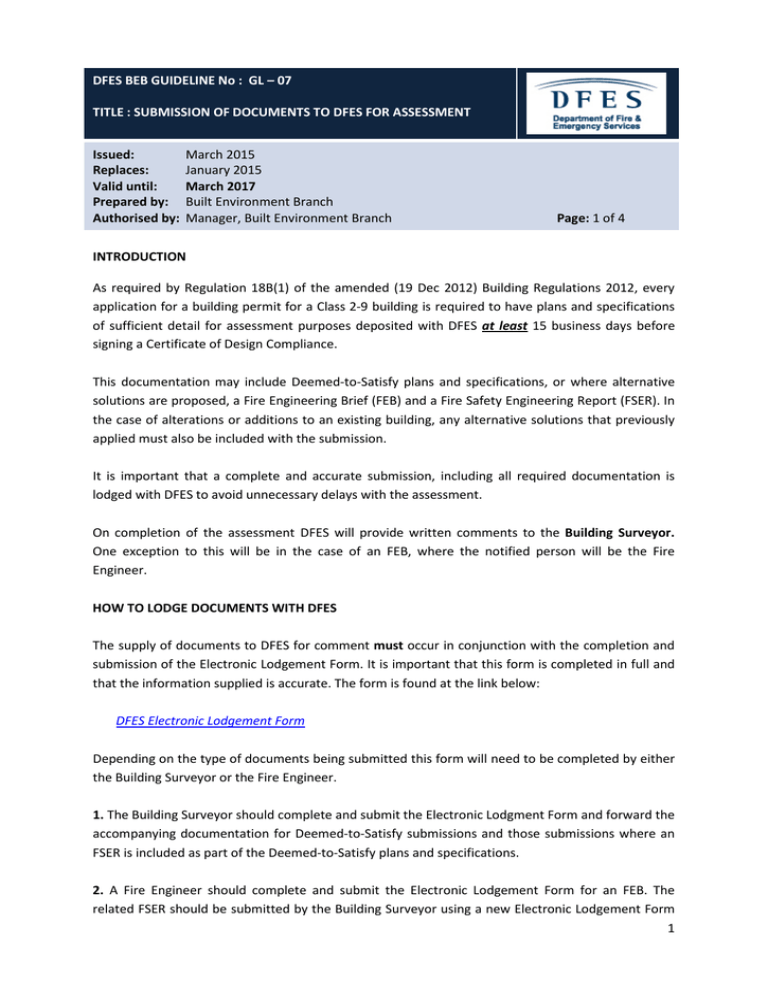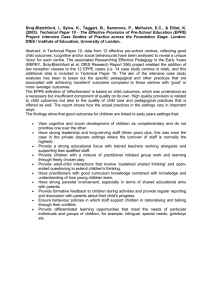SUBMISSION OF DOCUMENTS TO DFES FOR ASSESSMENT
advertisement

DFES BEB GUIDELINE No : GL – 07 TITLE : SUBMISSION OF DOCUMENTS TO DFES FOR ASSESSMENT Issued: Replaces: Valid until: Prepared by: Authorised by: March 2015 January 2015 March 2017 Built Environment Branch Manager, Built Environment Branch Page: 1 of 4 INTRODUCTION As required by Regulation 18B(1) of the amended (19 Dec 2012) Building Regulations 2012, every application for a building permit for a Class 2-9 building is required to have plans and specifications of sufficient detail for assessment purposes deposited with DFES at least 15 business days before signing a Certificate of Design Compliance. This documentation may include Deemed-to-Satisfy plans and specifications, or where alternative solutions are proposed, a Fire Engineering Brief (FEB) and a Fire Safety Engineering Report (FSER). In the case of alterations or additions to an existing building, any alternative solutions that previously applied must also be included with the submission. It is important that a complete and accurate submission, including all required documentation is lodged with DFES to avoid unnecessary delays with the assessment. On completion of the assessment DFES will provide written comments to the Building Surveyor. One exception to this will be in the case of an FEB, where the notified person will be the Fire Engineer. HOW TO LODGE DOCUMENTS WITH DFES The supply of documents to DFES for comment must occur in conjunction with the completion and submission of the Electronic Lodgement Form. It is important that this form is completed in full and that the information supplied is accurate. The form is found at the link below: DFES Electronic Lodgement Form Depending on the type of documents being submitted this form will need to be completed by either the Building Surveyor or the Fire Engineer. 1. The Building Surveyor should complete and submit the Electronic Lodgment Form and forward the accompanying documentation for Deemed-to-Satisfy submissions and those submissions where an FSER is included as part of the Deemed-to-Satisfy plans and specifications. 2. A Fire Engineer should complete and submit the Electronic Lodgement Form for an FEB. The related FSER should be submitted by the Building Surveyor using a new Electronic Lodgement Form 1 and only after receipt of DFES comments in relation to the FEB. Hard copies must be posted to: DFES Built Environment Branch, PO Box P1174, PERTH WA 6844, or alternatively delivered to, DFES Emergency Services Complex, 20 Stockton Bend, Cockburn Central, WA 6164. Please note that the only documents that DFES can receive electronically are the FEB and the FSER, however a hardcopy of each is also required. Electronic copies are to be sent to bebreports@dfes.wa.gov.au. DFES will acknowledge the receipt of the Electronic Lodgement Form and all submission documents by way of an email. If you have not received an email acknowledgement please contact the Built Environment Branch (BEB) bebadmin@dfes.wa.gov.au. REQUIRED PLANS AND SPECIFICATIONS (Items 1 to 5 below, as applicable). Please note that only one copy of each of the documents is required by DFES and that they must be the same revision number as those being submitted to the Permit Issuing Authority with the Certificate of Design Compliance. It is also essential that all plans and specifications are single sided, TRUE TO SCALE (see below for detail) and are of at least A3 size. Failure to do so will result in the assessment being put on hold until suitable plans are received. 1. Hydraulic Fire services Should include: • Drawings of compliant hose coverage from installed hydrants and/or fire appliance. • Where it is proposed to use street hydrants -Their location sho uld be marked and a g a i n shown how compliant hose coverage will be achieved. • Recent hydrant mains performance test results to be supplied where the hydrant and/or sprinkler system will rely on street mains performance. • • • • 2. Location and sufficient details of - ring mains, isolation valves, booster assembly, pumps and tanks including hard suction connections, pump controls and indicators. A schematic drawing is required for complex buildings that involve pumps. Location of appropriate fire brigade vehicle access and hard-standing. Fire sprinkler drawings showing the grade of water supply, design flow rate, booster assembly, control assembly/s, pumps and drenchers. Mechanical Fire services indicating Should include: • Ductwork layout including fire and smoke dampers. • Smoke exhaust and vent outlet locations, exhaust fan capacities and area of inlets. • Stairwell pressurisation inlet and relief grille locations. 2 3. Electrical Fire services indicating Should include: • The type of fire detection and alarm systems, including BOWS. • The location of the fire indicator panel and sub indicator panel/s if applicable. • The location of the main electrical switchboard and any high voltage installations. Please note: Where the fire detection and alarm system proposed for the building is required to be connected to the Direct Brigade Alarm (DBA) system, the DFES DBA Manager should be contacted on: Direct (08) 9395 9865, Mobile 0408 958 483, or at reception (08) 9395 9300. 4. Architectural Drawings Should include: 4.1. Site Plan (scale not less than 1:500) showing: • If part of an existing building, clear indication of the area that is the subject of the current submission. • Street name/s, boundaries, main entry, vehicular access and north point. • The dimensioned position of the proposed building and clear representation of existing buildings on the site (including existing floor area calculations and existing fire services). • Levels of the site in relation to the street. • Retaining walls, embankments, fences, electronic gates or other impediments to fire brigade entry onto the site or into the building. 4.2. Floor plans (dimensioned and to scale not less than 1:100) showing: • • • • • • If part of an existing building, clear indication of the area that is the subject of the current submission. Each storey, including basements and mezzanine levels. Clear and accurate indication of any fire and smoke compartmentation including floor areas (and volume of fire compartments). Fire resistance level (FRL) of firewalls and fire doors. Height and layout of any storage racking. If applicable, detail of materials to be stored in quantities that require a Dangerous Goods License. 4.3. Elevations and sections • Height of each level or storey. • The effective building height as defined in the Building Code of Australia (BCA) (for multi-storey buildings). Fire and smoke compartmentation. • 5. Alternative Solutions Refer to DFES Guideline No 15 for complete information on submitting fire safety engineered alternative solutions. 3 However, it is important that following the DFES assessment of the FEB, the FSER with all the appropriate plans and specifications documentation should then be lodged together in conjunction with a new Electronic Lodgement Form. If applicable, the fire modelling input and output files should ALWAYS be submitted (in a usable format, ie electronic data) in conjunction with the FSER as this is considered to form part of the ‘plans and specifications for the building in sufficient detail'. APPLICABLE LEGISLATION: Building Act 2011 Building Regulations 2012 (as amended) Please note: This is a controlled document. DFES Guidelines are available on the DFES Website: www.dfes.wa.gov.au under Regulation and Compliance, Building Plan Assessment then click on Publications/Guidelines. Should the information provided in this guideline require further clarification, please contact DFES Built Environment Branch on (08) 9395 9800. Disclaimer The information contained in this publication is provided voluntarily as a public service by the Department of Fire and Emergency Services (DFES). This publication has been prepared in good faith and is derived from sources believed to reliable and accurate at the time of publication. Nevertheless, the reliability and accuracy of the information cannot be guaranteed and DFES expressly disclaims liability for any act or omission based on reliance on the information and for any consequences whether direct or indirect, arising from such act or omission. The publication is intended to be a guide only and readers should obtain their own independent advice and make their own necessary enquiries. 4


